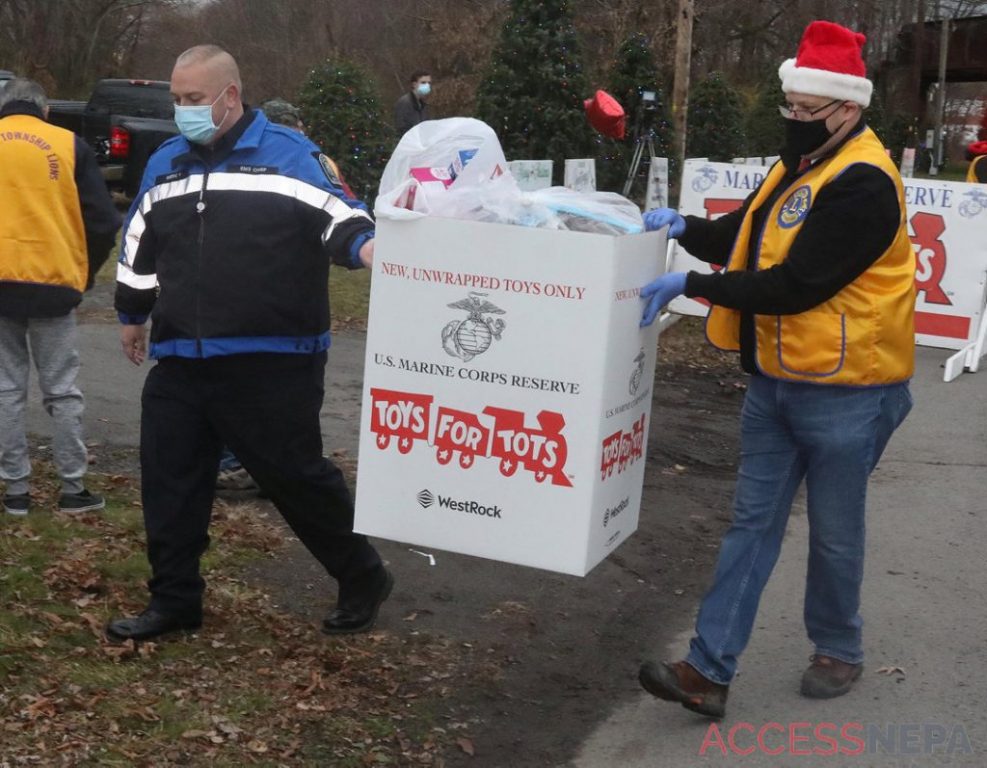As more people find themselves in need of help this year, the community has stepped up.
Charities and individuals continue to hold annual endeavors but also have found new ways to get food, money and other necessities to those who most need it. The Pew Research Center noted that nearly half of low-income Americans said they or someone in their household had lost income during the pandemic. Based on an increased need for help that they saw during the pandemic, groups such as the Salvation Army estimate up to 155% more people might receive Christmas assistance this year — as long as the organizations have the resources to do so.
While the deadlines have passed for some initiatives, some remain open, as do giving opportunities. Here’s how you can help — and get help from — a few local programs.
Salvation Army
The Salvation Army helps local families with clothing, food, heating assistance and more, and the public can help the cause by donating at any of the organization’s famous kettles set up around the area or online at salvationarmyusa.org.
Anybody is eligible to receive help, said Maj. Karen Schmig, corps officer/administrator at the Scranton office. Because of the pandemic, the SA prefers that people in need call its office at 570-344-9878 to make an appointment, and it can usually get them in the same day that they call.
Appointments give the SA time to prepare food boxes ahead of time and “put a little bit of love into it instead of just throwing it into a box,” Schmig said.
“We have been extremely busy,” she said. “We’re making appointments for everybody. This way we can take care of everybody better.”
The organization does not ask recipients for any proof of income or similar qualifications, although it does typically ask about the people in the household and their ages.
“If they say they need food, we don’t question it,” Schmig said.
The SA has a wide range of fresh and frozen foods plus canned goods and other pantry staples to hand out. The Commission on Economic Opportunity’s Weinberg Northeast Regional Food Bank keeps the SA well-stocked with food, bringing it donations at least once a week, Schmig noted. Sam’s Club also donates items, and the public can donate food directly to the SA, too. Schmig said donors should call the office first since they can only let volunteers inside.
“Give us a call, and then we can discuss it on the phone, what (our) needs are,” she said.

CHRISTOPHER DOLAN / STAFF PHOTOGRAPHER
Salvation Army Red Kettle bell ringer Sandra Hipsman of Jessup stands 6 feet away from the kettle while waiting for donations in December 2020 outside Sam’s Club in Dickson City.
While people previously could get food boxes every two months, since the COVID-19 pandemic began, the SA has changed that to every two weeks. And recipients get enough food to last them for that period.
For Christmas, the SA works with Toys for Tots to get local kids presents for the holidays. Applications opened at the beginning of September, and they filled up fast, Schmig said. The SA normally has 250 families participate, and as of late November, it had already reached 375 for this year. Anyone interested in being added to a possible waiting list can call Schmig.
The SA also puts together Christmas food boxes, which last year included a turkey and all the trimmings, and people may also be able to get gift cards for grocery stores.
“If we’re not able to help with the toys, at least we can help with the food box,” Schmig said.
The SA also serves as a kind of “middle man” for UGI, helping connect people who need help with the utility, Schmig said. That is open to certain income brackets, she noted, and the SA can help people figure out if they qualify. Clothing and furniture vouchers are on hold, but Schmig expects the clothing voucher program to start back up in January.
Toys for Tots
The Marine Corps Reserve Toys for Tots program began in 1947.
Locally, the Wyoming District campaign will collect new, unwrapped toys in local drop boxes through Dec. 15. Boxes are set up throughout the country at businesses and other locations, and local coordinators then collect and sort the donated toys according to age and gender. Toys for Tots does not donate to individual families; instead, community agencies, such as church groups and welfare organizations, hand out the toys to people in need. Last year, the Wyoming District distributed 46,894 toys to help 22,624 children.
People can donate toys by dropping them in official collection boxes scattered around the area or through the “virtual toybox” at toys fortotsbox.com. To donate money, visit toysfortots.org or mail a check made payable to Toys for Tots to the local coordinator, Staff Sgt. Matthew Jacobs, at 1118 Wyoming Ave., Wyoming, PA 18644.
People who want to request a toy can find details about several local nonprofits Toys for Tots works with at the local campaign’s website, wyoming-pa.toysfortots.org. For more information, email wyoming.pa@toysfortots.org or call 570-417-4775.
The annual Stuff the Bus for Toys for Tots collection will happen Thursday, Dec. 10, from 7 a.m. to 6 p.m. at Lackawanna Transit Center, 30 Lackawanna Ave., Scranton. Prospector from Rock 107, a Times-Shamrock Communications radio station, will broadcast live from the event that morning. Toy collections also will take place that day from 11 a.m. to 1:30 p.m. on the Spruce Street side of Lackawanna County Courthouse Square, Scranton.

DAVE SCHERBENCO / STAFF PHOTOGRAPHER
Hanover Twp. chief paramedic Chris Wollfolk, left, and Lions Club event coordinator John VanWhy carry some toy donations during Saturday’s Toys for Tots collection along West End Road in Hanover Twp.
Adopt an Angel
Lackawanna County’s Adopt an Angel benefits children in foster care or who have open cases with the county’s Office of Youth and Family Services, which ranges from newborns to age 21. The program benefits approximately 500 children each year, said Mary Kay Pivovarnik, a case manager helping coordinate Adopt an Angel with Sharon Roginski and Donna Karoscik.
“With COVID and so many people losing their jobs, we have more open cases now than we have had in years,” Pivovarnik said. “Our case-loads are up, and it has a lot to do with homelessness and employment issues, job issues. We have a lot of stuff going on in the county now, and we’re really trying to give support to those families and take one more thing off their plate.”
The program is volunteer-run within the agency, Pivovarnik said, and the county does not contribute any money. Instead, the program relies on the community to step up and asks donors to spend about $100 per child. Donors can request certain ages, genders or even to help siblings, and the coordinators try to fulfill those requests. The children fill out a letter to Santa, which the donors can then use to guide them as they pick out gifts.
“We get all kinds of requests,” Pivovarnik said. “A lot of the younger kids ask for toys. Some of them ask for bedding, pajamas, winter coats and hats. It varies depending on the child. Sometimes a child will write things and parents will add on. Parents of small children often ask for diapers or a stroller. Sometimes they ask for one big item.”
As of late November, the program had about 400 children to help, and Pivovarnik expected a “second rush” to bring in another 100 kids. Of the 400, she still had about 50 to 60 angels without sponsors.
The volunteers go shopping right through Christmas Eve, using monetary donations to cover the cost of gifts for remaining unsponsored angels or children who were placed with the children and youth office at the last minute.
“We have a lot of elves in our office who help out with them,” said Pivovarnik, whose house ends up filled with gifts like Santa’s workshop. “I shopped for 10 kids (one weekend). I’m trying to get a jump on the older ones who I know we don’t generally get a sponsor for.”
All of the gifts eventually end up at Keyser Valley Community Center in Scranton for sorting.
“When all of the gifts start coming in and we have 400 kids’ worth of gifts in one place? To see the amount is just so amazing,” Pivovarnik said.
Pivovarnik sometimes hears from the families whose children benefitted from the program and even sees pictures of them on Christmas morning.
“It’s really incredible,” she said. “We do a lot of things with our clients, but to be able to see this type of joy? For the children to be able to write a letter to Santa and for them to actually get what they want? … All of the community is really who helps and supports this. We wouldn’t be able to do it without them.”
To help, email pivovarnikm@lackawannacounty.org or call 570-963-6781. Drop off will take place at Keyser Valley Community Center, 101 N. Keyser Ave., Scranton, on Tuesdays and Thursdays from 3 to 5 p.m. through Dec. 10 and Saturday, Dec. 12, from 10 a.m. to 2 p.m.

Caitlin Heaney West is the content editor for Access NEPA and oversees the Early Access blog in addition to working as a copy editor and staff writer for The Times-Tribune. An award-winning journalist, she is a summa cum laude graduate of Shippensburg University and also earned a master’s degree from Marywood University. Caitlin joined the Times-Shamrock family in 2009 and lives in Scranton. Contact: cwest@timesshamrock.com; 570-348-9100 x5107; or @cheaneywest




